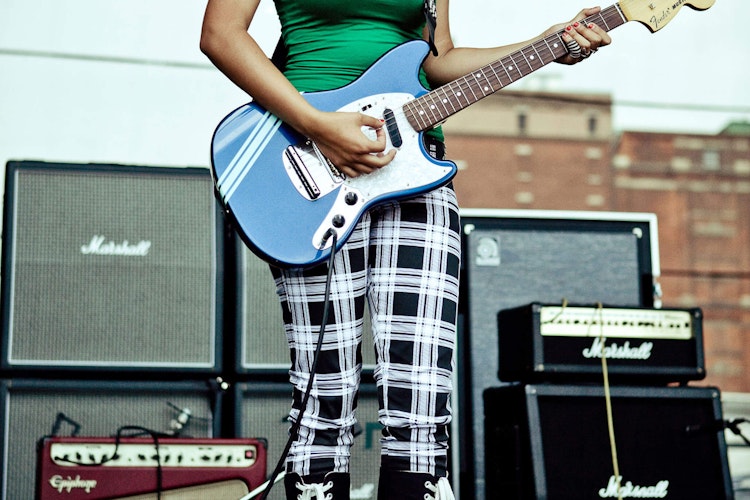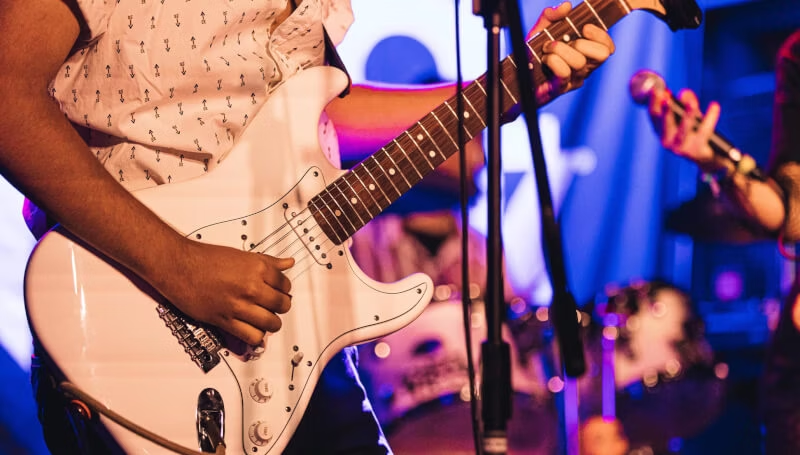So, you’re set up with your first electric guitar. Now it’s time to pick out your first amplifier! Guitar amps come in all shapes and sizes, with many options to choose from. Are you going to be jamming at home or taking the show on the road?
In this guitar amp buying guide, School of Rock breaks down the basics of amps so you can find the perfect amp for your needs.
Click below to jump to a guitar amp guide section.
Guitar amp basics
Before we get started, let’s look at some basic things you’ll need to understand in order to find the best guitar amp that fits your needs. When searching for their first guitar amp, it’s best for beginners to start with what’s known as a combo amp.
Combo amps combine the speakers with the preamplifier and the power amplifier. The preamp shapes the tone of the guitar, and the power amp pushes the sound to the speakers.
Of course, that's just the basics when it comes to guitar amps, and there are many factors to consider when selecting one that best fits your music style and preferences.
"When searching for their first guitar amp, it’s best for beginners to start with a combo amp."
CHOOSING BETWEEN A COMBO AMP & AN AMP HEAD AND CAB
As noted above, combo amps combine the amp, preamp, and speakers in one unit. The other main configuration is to have a separate “head” (the electronic component of an amp, minus speakers) hooked up to a separate speaker cabinet.
For practicing at home or on the road, most guitarists choose combo amps for their smaller size and portability.
Combo amps tend to be smaller in size but packed with added features, such as headphone jacks and input jacks that will allow you to play along with your favorite recordings.
Pro tip: Try your guitar amp before you buy it
You wouldn’t buy shoes without first trying them on, and the same can be said for a guitar amp. When buying a guitar amp, bring your guitar to the store so you can test it out first. After making sure your guitar is in tune, ask your local music shop to help you set up the amp so you can try it before you buy it.
Check out what School of Rock recommends
Is there a difference between a bass amp and a guitar amp?

Guitar and bass amps are two very different pieces of equipment; each is designed to optimize their respective instruments. A guitar amp can’t reproduce the very low frequencies generated by a bass guitar, and bass amps tend to make guitars sound lifeless and uninteresting. A dedicated guitar amp will produce tones that sound better and inspire you to practice more.
How to choose your first guitar amp
There are a lot of factors to consider when purchasing your first guitar amp, and you want to make sure that you’re making a good investment. Let’s look at some of the features you’ll want to look for so you can pick the best guitar amp for beginners.
Guitar amp size and portability
When it comes to selecting your first guitar amp, choosing the best size is a great place to start. When it comes to sizing, guitar amps range from tiny micro amps to giant rigs with multiple speaker cabinets.
What size guitar amp do you need for practicing?
When you are just starting out on guitar, a small practice amp will be all that you generally need to get started. Because of their smaller size, these guitar amps are also great for musicians who travel for whatever reason, either on the road or to their next band practice.
SPEAKERS AND GUITAR AMP WATTAGE
When choosing your guitar amp, two factors to take into consideration are the wattage of the amp and the configuration of your speakers.
CHOOSING GUITAR AMP WATTAGE
There are many misconceptions about the necessary wattage needed for a guitar amplifier. Most “pro” amps are 30-100 watts. Loudness doesn’t double when you double the number of watts. A 30-watt amp is only 5 decibels quieter than a 100-watt amp.

Choosing speaker configuration
Most amps sound best when they can be turned up about halfway. If your guitar amp never gets turned up past 3, you should probably use a smaller amp. You want to make sure the speakers are rated for the amount of power the amp will produce.
When choosing your speaker configuration, two factors to take into consideration are the wattage of the amp and impedance. Popular speaker configurations include one 12-inch speaker, two 12-inch speakers, and four 12-inch speakers. For most gigs, one 12-inch or two 12-inch speakers are fine. Remember: In most cases, your amp will be connected to the PA system.
Practicing at home vs. playing on the road
For home use, you really don’t need a guitar amp that uses more than 20 watts of power. Having a high-powered amp at home is like having a race car that you can’t drive over 20 mph. You don’t need a lot of wattage to sound good.
Likewise, most practice amps have a single speaker between 8 inches and 12 inches in diameter. The practice amp is for practicing at home at a reasonable volume — save the big amp for the stage.
Reading guitar tabs is a great habit to incorporate into practice, and practice is only made easier with School of Rock’s Method App.
Get realtime performance feedback
You don't have to practice the guitar on your own. With the School of Rock Method app, you can get live feedback as you play to make practice smarter, not harder.
Check out the School of Rock Method
Recording in the studio
If you want to use your guitar amp in a recording situation, smaller is usually better. For instance, Jimmy Page used a small 15-watt Supro combo amp in the studio to create the huge guitar sounds on the early Led Zeppelin records.
Some guitarists will use multiple amps in the studio and blend their sounds to get the perfect tone. The possibilities are endless.
Amps for playing live onstage
The same pretty much holds true for playing live: Gigantic guitar amps are no longer needed, as most venues use microphones on the amps to better control the sound that the audience hears. You’ll usually also have onstage monitors that will provide sound to you and your bandmates. The only real consideration is being able to compete with the natural volume of the drum set.
When you see bands play arenas, they often use dummy cabs onstage for looks — most don’t even contain speakers! The most power you’ll generally need to play live in most situations is 30–50 watts. A cab with one or two 12-inch speakers will probably be fine for live shows.
For really big venues, a 4x12 cab is sometimes used, especially for heavier bands. Save the full stack 100-watt amp and multiple cabs for when you hit the big time!
Guitar amp tone and effects
The kind of music you want to play will affect what kind of guitar amp you want to buy. A basic understanding of amp tones and effects can help you make your final decision.
1. EQ controls and settings
All guitar amps will have some sort of “equalization” (or EQ) built in. These controls are usually labeled treble, mid, and bass. These controls help you achieve your desired tone. EQ is an important part of any amp. These controls will help you sound good in any environment, as you can shape the amp’s frequencies to sound best in whatever room you’re playing in.
2. Distortion
Most guitar amps will have a gain knob. This controls the amount of distortion in your sound. For instance, heavy metal and punk bands usually have a thick, distorted tone.
3. Reverb
Reverb is a standard effect that sounds like an echo in a big empty room. While not every guitar amp features reverb, it can be found on most practice amps.
4. Digital effects
Effects can be a useful feature in many different guitar amps, but it’s best for beginners not to get carried away. Eventually, though, guitarists may have a need for them. Some amps feature an array of digital onboard effects that you choose from. Many professional players use pedal boards that they customize with several effects pedals.
Having digital effects built into the guitar amp allows you to experiment with several effects without having to buy the pedals separately. Then when you’re looking to upgrade to a bigger amp to play live, you can pick and choose exactly what effect pedals you want to use.
5. Multiple channels
Another feature that some guitar amps have is the ability to switch between two or three channels that feature different types of sounds. This is usually achieved through the use of a foot switch that allows you to toggle back and forth between the channels. Some single-channel guitar amps also have a foot switch that will turn the effects on and off.
Guitar amp Quality
While all these extra features are fun to play with, the overall quality of the guitar amp is a very important consideration. Trusted guitar amp manufacturers such as Fender make great quality amps with a wide range of prices and features.
Fender is a GearSelect partner of School of Rock, and we use their amps extensively in our schools and recommend them to our students. Fender guitar amps are well-built and sound great, which makes practice a breeze. Many vintage Fender amps from the ‘50s, ‘60s, and ‘70s are still in use today, which speaks to their durability and quality.
Guitar amp flexibility
Another important consideration is the style of music you’ll mostly be playing. The best guitar amp for practice will be able to cover a wide array of musical styles, from metal to country to jazz. Some more experienced players with a more narrow focus may opt for a “one-trick pony” amp that nails their desired tone. For beginners, it’s best to select the best guitar amp for them that provides the flexibility to experiment. This is usually better than being stuck with one sound, and can make practice more fun.
Types of guitar amps
There are many different types of guitar amps on the market. The two main types are tube amps and solid-state amps. Hybrid amps combine tube and solid-state technologies. Modeling amps are generally solid-state and offer sounds that are “modeled” from several well-known amps.

Solid-state vs. tube guitar amps
Most pro-level stage amps are powered by tubes (the small glass “bottles” that carry voltage through your amp), the exception being modeling or “profiler” amps. Tube amps are known for their rich, thick sound and pleasing harmonic distortion. Solid-state amps are improving, and some metal guitarists like the quick attack and tight bass of solid-state amps.
Should beginners use a solid-state or tube guitar amp?
Solid-state amps are generally more reliable and don’t require the maintenance associated with tube amps. This makes solid-state amps the better plug-and-play choice for beginners looking for their first guitar amp.
What are the benefits of hybrid guitar amps?
Hybrid amps feature the best parts of tube and solid-state amps together. While some vintage hybrid amps feature tube power sections and solid-state preamps, most modern practice amps have a tube preamp section and a solid-state power amp section.
How to choose the best hybrid guitar amp
Look for a hybrid guitar amp that features the legendary 12AX7 preamp tubes. This is generally better because it allows the less-expensive preamp tubes to shape the amp’s sound and the more reliable solid-state technology to power the amp.
Modeling guitar amps
Over the past 25 years, modeling amps have become very popular for beginners and guitar enthusiasts that mostly play at home.
What are the benefits of modeling guitar amps?
Modeling amps feature the sounds of many amps in one package. In the past few years, many pros have begun using “profiler” amps live that feature sounds that come from analyzing sought-after vintage amps. This allows them to access hundreds of great tones in a single amp.
Are modeling guitar amps good for beginners?
Modeling amps can be great choices for beginners. They allow you to sample various iconic guitar amp models and tones, helping you find the sound that’s right for you.
How to choose the best modeling guitar amp
When buying a modeling amp, choose one that has a wide variety of modeling, ranging from clean Fender-type tones to more aggressive Marshall high-gain tones. Likewise, look for a nice variety of effects that include reverb, delay, phaser, flanger, and tremolo.
PLAY GUITAR IN REAL PERFORMANCES ONSTAGE
Our music programs are taught by practicing musicians with the experience you need to learn to play. Perform live shows and develop your skills in a supportive learning environment for all skill levels.
Learn to play

Other types of guitar amps
When looking at what’s best for your guitar, you also have types of amps to choose from that are made for specific uses. These amps are designed for more specific uses but may be useful for any musician.
Acoustic guitar amps
There are many amps dedicated to just acoustic guitars and live, onstage performance. These amps allow you to use effects with your acoustic guitar in the same way you would with your electric guitar. An acoustic guitar amp also allows you to add some sounds to your instrument that could normally only be produced with an electric guitar amp.
Guitar amp simulators
For recording your electric guitar at home, you can use electric guitar amp simulation software. This also allows you to practice silently through headphones or through computer monitor speakers. Some bands even use the guitar amp simulator software in their live shows rather than using amps.
What School of Rock recommends for our students
Picking the best guitar amp for you will make practicing more enjoyable and provide a great experience that makes learning how to play music more fun. School of Rock recommends students purchase a small, inexpensive practice amp, such as a Fender Mustang, that offers a wide range of sounds and multiple features in a small, portable package.
There’s no need to purchase a stage amp. School of Rock provides larger amps for rehearsals and live performances. We encourage our students to try several amps and compare features in order to make an informed, educated buying decision. Life is too short for bad tone!
Ready to get started?
Now that you’ve read our guitar amp buying guide, you should hopefully have a pretty good idea about how to choose the best guitar amp for beginners and what size you need for practice (we also have advice on how to buy a guitar for beginners).
Starting a new instrument can be fun, but it doesn’t have to be hard. And picking the best guitar amp for your needs is only the beginning of your music journey.
Learning with our performance-first approach
At School of Rock, our instructors walk with you step by step to teach you how to play guitar with skill and confidence. We make learning an instrument fun so you can get up onstage and rock in a band.
Students can use our Method App to practice songs and receive real-time feedback so they can see how they’re doing and what they need to improve.









